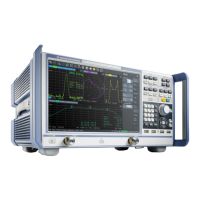GUI Reference
R&S
®
ZNB/ZNBT
586User Manual 1173.9163.02 ─ 55
●
If "Auto Length and Loss" is used with a line connected to a test port, the end of the
line should be left open.
●
To calculate the electrical length offset and loss of port i, you have to select a trace
that uses port i as one of its receive ports. It is not relevant for the "Auto Length
and Loss" function which Port is selected.
If the measured quantity is a ratio, or if it is derived from a ratio, its receiving port is
given as the index of the wave quantity in the numerator. If the active trace shows an
S-parameter S
ij
, then "Auto Length" adds a length offset at port i. If the receive port is
balanced, then the same offset and length is applied to both its physical ports.
Remote command:
[SENSe<Ch>:]CORRection:LOSS:AUTO
Fixture Compensation...
The "Fixture Compensation..." button opens the Fixture Compensation Dialog.
Evaluation Range...
The "Evaluation Range..." button opens the Evaluation Range Dialog that allows you to
restrict the frequency range of auto length (and loss) calculations.
6.13.4 Single Ended Tab
Allows you to specify 2-port deembedding/embedding networks for each physical port.
Such a network is either defined:
●
via its S-parameters stored in a two-port Touchstone file (*.s2p) or
●
by selecting a predefined lumped element model and specifying the available
parameters (resistances/conductances, capacitances, inductances)
See Chapter 5.6.2.3, "Circuit Models for 2-Port Networks", on page 190.
Use the complementary dock widget to activate or deactivate dembedding/embedding
for selected ports (see Chapter 6.13.1.3, "Single Ended Panel", on page 571).
Background information
Refer to the section Chapter 5.6.2.10, "Combining Several De-/Embedding Networks",
on page 198.
Offset Embed Softtool

